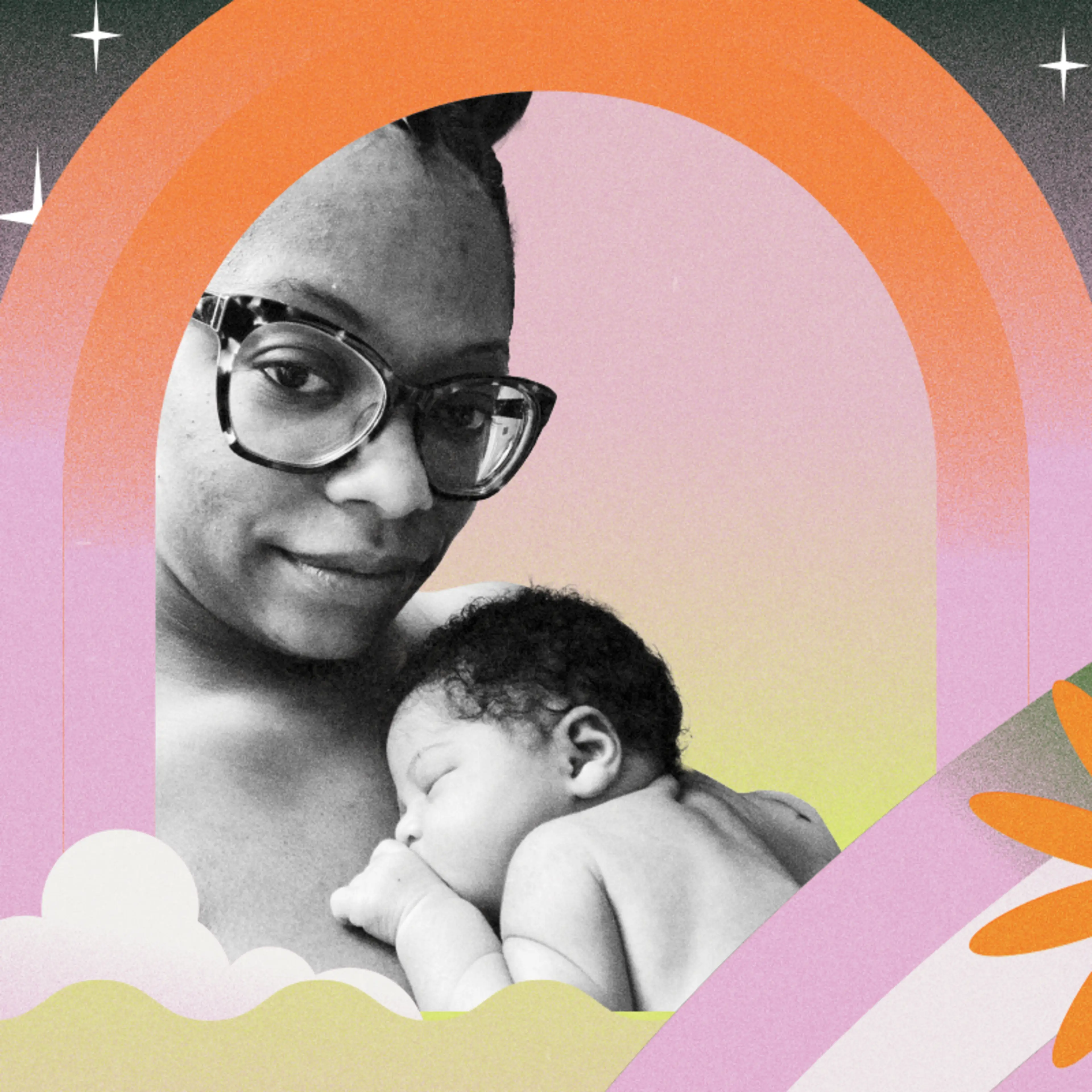I begged for an epidural during my first labor. After getting a membrane sweep four days before my due date, my contractions started and within a matter of hours ramped up from light cramps to arriving at the hospital feeling like my uterus was on fire. In that moment, everything I’d learned in my brief childbirth course for managing the pain flew out the window and the doctor couldn’t give me an epidural fast enough.
When I found out I was pregnant with my second at the beginning of 2021, I decided to try a different route—an unmedicated home birth. While I was grateful for the epidural the first time around, and while the idea of going without pain management was intimidating, the idea of letting my body experience birth without interventions and in the comfort of my own home felt empowering and sounded sort of magical.
While I was excited about my new birth plan, I knew there would be a lot of things to learn in order to soothe some of my fears—fears only amplified by the responses I received when I told the people in my life what I was planning to do. So, I dove head first into mentally and physically preparing myself for the experience.
Deciding how you want to give birth is a deeply personal and emotional decision. No matter what your birth story is, your body and what it’s accomplished are amazing. But if attempting an unmedicated birth is something you want to try, here are some tips based on my own experience that can help you figure out how to prepare in a way that helps you feel more empowered and a little less scared.
Find the Right Support System
If you decide you want to skip the epidural, start by lining up the right care team. I knew two minutes into the interview with my midwife that she was the one. She was actually part of a team of two, so I ended up having two amazing women supporting me through pregnancy, birth, and the fourth trimester.
My main criteria for choosing my midwife was finding someone who offered more personalized care and who I felt really comfortable with. That’s exactly what I got. Each appointment was at least an hour long, and we would spend most of the time chatting about how I was feeling, making sure I was taking care of myself as best I could, and planning for postpartum.
Remind Your Brain—and Yourself—That Birth is Normal
Birth is a biologically normal event, though it’s become very “medical,” which isn’t always necessary. Before I gave birth myself, the image of someone having a baby consisted of a sweaty, frazzled woman who was screaming through each contraction (contractions that never seemed to end). If you’ve seen Knocked Up you know what I mean. Giving birth is physically taxing, sure. But it doesn’t have to be an out-of-control, stressed-out whirlwind. Regardless of where or how you give birth, it can be peaceful, calm, and special.
With the help of my midwives, I put in the work to change my perception of childbirth. I curated my feed by following birth photography, home birth, hypnobirthing, and positive birth accounts so I could move away from Hollywood’s portrayal of labor and create a new framework. I also watched birth vlogs on YouTube and joined Facebook groups where people shared their birth stories.
A few accounts I found helpful were:
Get Familiar with What Actually Happens During Labor and Birth
I’ve always been a chronic researcher—pregnancy and birth were no exception. With a planned unmedicated birth on the horizon, I dug deep to find out what really happens during labor.
I learned there is a lot going on behind the scenes, all led by an orchestra of hormones that work together to direct your body toward birthing your baby. I took a birth course that went into a lot of detail on what was happening during each stage of labor and why. While sometimes things happen that we don’t expect (and it certainly doesn’t mean you’ve failed), understanding what’s happening and why during the normal progression of labor helped me more fully believe and trust that my body is made to give birth.
Take a Hypnobirthing Class
I was completely unprepared for the power of contractions during my first labor. Since I was planning to get an epidural, I didn’t spend much time learning how to cope with them. Looking back, I now realize I was moving in ways that weren’t helpful and holding my breath instead of breathing through the pain. My first birth at one point ending in me screaming, “Epidural now!”, so I knew I’d really have to internalize coping techniques for a home birth since medical pain relief options wouldn’t be available.
Enter The Positive Birth Company course. It combined labor and birth basics with hypnobirthing techniques that cope with the sensations of labor. No, we’re not talking about a stopwatch swinging before your eyes, lulling you into hypnosis. It’s essentially a mindfulness practice. The biggest thing I learned was to reframe how I thought of contractions. Anticipating something will be painful, usually makes it hurt more (think of tensing up before a vaccination or getting a tattoo). “Contractions” = surges and “pain” = strong. Shifting perspective from preparing for painful contractions to getting ready for strong surges helped soothe my fears and allowed my mind to perceive them differently. The course also taught me calming breathing techniques and visualizations that I relied on during my second birth.
Learn How to Move
The typical depiction of labor shows someone laboring on their back hooked up to an epidural. While staying stationary, especially after receiving an epidural or IV, has been the common practice for decades, more light is being shed on the benefits of positioning and movement during labor, and some hospitals are even starting to support this.
The reason movement is important is because, as your labor progresses, your baby is making thier own intricate shifts and turns to navigate through the birth canal and the pelvis. There are things you can do to help them. Toward the end of my pregnancy and early labor, I spent a lot of time bouncing on my beloved birthing ball. Other movements like gentle lunges or circling your hips also help to “open” the pelvis and create space for baby to move down and through. I found swaying side to side during surges while using the breathing method I learned in the hypnobirthing course to be the most helpful. You can alternate through a few different positions, listening to what feels best to your body. Changing up positioning and movement also encourages optimal positioning and helps with riding the waves of contractions.
Also, don’t be afraid to use the toilet as a tool! Sitting on the toilet facing the tank is so helpful for opening up the pelvis and creating space for the baby to move down. It’s also really comfortable in a way that’s hard to put into words.
Environment as a Comfort Measure
One of the most important hormones at play during labor is oxytocin. It drives contractions, which are necessary to dilate and thin the cervix so the baby can pass through. (Fun fact: pitocin, the medicine used to induce labor, is a synthetic form of oxytocin). Your birth environment can impact the levels of oxytocin during labor. If you’re not feeling safe, supported, or comfortable during labor, oxytocin levels can drop. This can lead to labor slowing down or even stalling. The good news is, whether you’re giving birth at home, a birth center, or a hospital, you can set your environment up so it’s oxytocin-friendly. Keep the lighting dim and cozy. Surround yourself with supportive people. You can also add special touches like fairy lights, affirmation cards, flameless candles, and soothing scents and music.
Make a Plan, Then Let Go of Expectations
Perhaps the biggest piece of advice I would give is to let go of any and all expectations. While a birth plan helps let your care team know your wishes for your labor and delivery, keep in mind that things don’t always happen the way you’ve designed them to. Preparing yourself ahead of time by going into birth with a level of acceptance that this is ultimately out of your control can help you cope if things don’t turn out how you hoped.
For my daughter’s birth, I set up battery-operated candles, taped up affirmations, and strung fairy lights in the bedroom. I imagined a serene, beautiful labor that would take place in the birth pool. My husband had just finished filling it up when my baby suddenly decided it was time. I labored in our tiny bathroom with the lights off, alternating between sitting on the toilet and standing at the sink swaying side to side with the Freya app guiding me through each contraction. My little Sagittarius baby was born on a Tuesday at 7:34 a.m., on the bathroom floor—and I wouldn’t change a thing about my birth experience.











